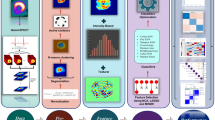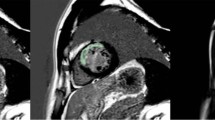Abstract
Cardiac magnetic resonance cine images are primarily used to evaluate functional consequences, whereas limited information is extracted from the noncontrast pixel-wise myocardial signal intensity pattern. In this study we want to assess whether characterizing this inherent contrast pattern of noncontrast-enhanced short axis (SAX) cine images via radiomics is sufficient to distinguish subjects with acute myocardial infarction (AMI) from controls. Cine balanced steady-state free-precession images acquired at 1.5 T from 99 AMI and 49 control patients were included. First, radiomic feature extraction of the left ventricular myocardium of end-diastolic (ED) and end-systolic (ES) frames was performed based on automated (AUTO) or manually corrected (MAN) segmentations. Next, top features were selected based on optimal classification results using a support vector machine (SVM) approach. The classification performances of the four radiomics models (using AUTO or MAN segmented ED or ES images), were measured by AUC, classification accuracy (CA), F1-score, sensitivity and specificity. The most accurate model was found when combining the features RunLengthNonUniformity, ClusterShade and Median obtained from the manually segmented ES images (CA = 0.846, F1 score = 0.847). ED analysis performed worse than ES, with lower CA and F1 scores (0.769 and 0.770, respectively). Manual correction of automated contours resulted in similar model features as the automated segmentations and did not improve classification results. A radiomics analysis can capture the inherent contrast in noncontrast mid-ventricular SAX cine images to distinguishing AMI from healthy subjects. The ES radiomics model was more accurate than the ED model. Manual correction of the autosegmentation did not provide significant classification improvements.


Similar content being viewed by others
Abbreviations
- AMI:
-
Acute myocardial infarct
- AUC:
-
Area under the curve
- AUTO:
-
Automated
- bSSFP:
-
Balanced steady-state free-precession
- CC:
-
Pearson correlation coefficient
- Cx:
-
Circumflex artery
- EDV:
-
End-diastolic volume
- ESV:
-
End-systolic volume
- GLCM:
-
Gray level co-occurrence matrix
- GLDLM:
-
Gray level dependence matrix
- GLRLM:
-
Gray level run length matrix
- GLSZM:
-
Gray level size zone matrix
- HR:
-
Heart rate
- IMH:
-
Intramyocardial hemorrhage
- LAD:
-
Left anterior descending
- LASSO:
-
Least absolute shrinkage and selection operator
- LV:
-
Left ventricle
- LVEF:
-
Left ventricular ejection fraction
- MI:
-
Myocardial infarction
- MAN:
-
Manual
- MR:
-
Magnetic resonance
- MVO:
-
Microvascular obstruction
- RCA:
-
Right coronary artery
- ROC:
-
Receiver operating characteristic
- SV:
-
Stroke volume
- SVM:
-
Support vector machine
References
Khan JN, McCann GP (2017) Cardiovascular magnetic resonance imaging assessment of outcomes in acute myocardial infarction. World J Cardiol 9:109–133. https://doi.org/10.4330/wjc.v9.i2.109
Kramer CM, Barkhausen J, Bucciarelli-Ducci C, Flamm SD, Kim RJ, Nagel E (2020) Standardized cardiovascular magnetic resonance imaging (CMR) protocols: 2020 update. J Cardiovasc Magn Reson 22(1):17. https://doi.org/10.1186/s12968-020-00607-1
Brünjes R, Hofmann T (2020) Anthropogenic gadolinium in freshwater and drinking water systems. Water Res 182:115966. https://doi.org/10.1016/j.watres.2020.115966
Gillies RJ, Kinahan PE, Hricak H (2016) Radiomics: images are more than pictures, they are data. Radiology 278:563–577. https://doi.org/10.1148/radiol.2015151169
Raisi-Estabragh Z, Izquierdo C, Campello VM et al (2020) Cardiac magnetic resonance radiomics: basic principles and clinical perspectives. Eur Heart J CVI 21:349–356. https://doi.org/10.1186/s12968-017-0325-y
Nordlund D, Kanski M, Jablonowski R et al (2017) Experimental validation of contrast-enhanced SSFP cine CMR for quantification of myocardium at risk in acute myocardial infarction. J Cardiovasc Magn Reason 19:12. https://doi.org/10.1186/s12968-017-0325-y
Abdulkareem M, Kenawy AA, Rauseo E et al (2022) Predicting post-contrast information from contrast agent free cardiac MRI using machine learning: challenges and methods. Front Cardiovasc Med 9:894503. https://doi.org/10.1016/j.compbiomed.2021.105145
Avard E, Shiri I, Hajianfar G et al (2022) Noncontrast cine cardiac magnetic resonance image radiomics features and machine learning algorithms for myocardial infarction detection. Comput Biol Med 141:105145
Baessler B, Mannil M, Oebel S, Maintz D, Alkadhi H, Manka R (2018) Subacute and chronic left ventricular myocardial scar: accuracy of texture analysis on nonenhanced cine MR images. Radiology 286(1):103–112. https://doi.org/10.1148/radiol.2017170213
Larroza A, Materka A, López-Lereu MP, Monmeneu JV, Bodí V, Moratal D (2017) Differentiation between acute and chronic myocardial infarction by means of texture analysis of late gadolinium enhancement and cine cardiac magnetic resonance imaging. Eur J Radiol 92:78–83. https://doi.org/10.1016/j.ejrad.2017.04.024
Larroza A, López-Lereu MP, Monmeneu JV, Gavara J, Chorro FJ, Bodí V, Moratal D (2018) Texture analysis of cardiac cine magnetic resonance imaging to detect nonviable segments in patients with chronic myocardial infarction. Med Phys 45:1471–1480. https://doi.org/10.1002/mp.12783
Durmaz E S, Karabacak M, Ozkara B B, et al. Radiomics-based machine learning models in STEMI: a promising tool for the prediction of major adverse cardiac events. Eur Radiol 2023. https://doi.org/10.1007/s00330-023-09394-6.
Alis D, Yergin M, Asmakutlu O, Topel C, Karaarslan E (2021) The influence of cardiac motion on radiomics features: radiomics features of non-enhanced CMR cine images greatly vary through the cardiac cycle. Eur Radiol 31(5):2706–2715. https://doi.org/10.1007/s00330-020-07370-y
Laube A, Ivantsits M, Hüllebrand M et al (2023) Influence of temporal sampling on reproducibility of radiomics features in cardiac cine MRI. In: Proceedings of the 32nd joint annual ISMRM & SMRT meeting, Toronto (abstract 4460)
Jang J, El-Rewaidy H, Ngo LH et al (2021) Sensitivity of myocardial radiomic features to imaging parameters in cardiac MR imaging. J Magn Reson Imaging 54:787–794. https://doi.org/10.1002/jmri.27581
Raisi-Estabragh Z, Gkontra P, Jaggi A et al (2020) Repeatability of cardiac magnetic resonance radiomics: a multi-centre multi-vendor test-retest study. Front Cardiovasc Med 7:586236. https://doi.org/10.3389/fcvm.2020.586236
Fedorov A, Beichel R, Kalpathy-Cramer J et al (2012) 3D Slicer as an image computing platform for the Quantitative Imaging Network. Magn Reson Imaging 30(9):1323–1341. https://doi.org/10.1016/j.mri.2012.05.001
van Griethuysen JJM, Fedorov A, Parmar C et al (2017) Computational radiomics system to decode the radiographic phenotype. Cancer Res 77:e104–e107. https://doi.org/10.1158/0008-5472.CAN-17-0339
Yu L, Liu H (2003) Feature selection for high-dimensional data: a fast correlation-based filter solution. In: Fawcett T, Mishra N (eds) Proceedings of the 20th international conference on machine learning (ICML-03). The AAAI Press, Menlo Park, pp 856–863
Demsar J, Curk T, Erjavec A et al (2013) Orange: data mining toolbox in Python. J Mach Learn Res 14:2349–2353
Papalini EI, Polte CL, Bobbio E, Lagerstrand KM (2022) Diagnosis of acute myocarditis using texture-based cardiac magnetic resonance, with CINE imaging as a novel tissue characterization technique. Diagnostics (Basel) 12(12):3187. https://doi.org/10.3390/diagnostics12123187
Steen H, Voss F, André F et al (2012) Clinical feasibility study for detection of myocardial oedema by a cine SSFP sequence in comparison to a conventional T2-weighted sequence. Clin Res Cardiol 101(2):125–131. https://doi.org/10.1007/s00392-011-0373-5
Kumar A, Beohar N, Arumana JM et al (2011) CMR imaging of edema in myocardial infarction using cine balanced steady-state free precession. JACC Cardiovasc Imaging 4(12):1265–1273. https://doi.org/10.1016/j.jcmg.2011.04.024
Goldfarb JW, McLaughlin J, Gray CA, Han J (2011) Cyclic CINE-balanced steady-state free precession image intensity variations: implications for the detection of myocardial edema. J Magn Reson Imaging 33:573–581. https://doi.org/10.1002/jmri.22368
Peng Y, Wu K, Wang YXJ, Gong J (2022) Association between cine CMR-based radiomics signature and microvascular obstruction in patients with ST-segment elevation myocardial infarction. J Thorac Dis 14(4):969–978. https://doi.org/10.21037/jtd-21-1706
Hassani C, Saremi F, Varghese BA, Duddalwar V (2020) Myocardial radiomics in cardiac MRI. Am J Roentgen 214:536–545. https://doi.org/10.2214/AJR.19.21986
Funding
The authors declare that no funds, grants, or other support were received during the preparation of this manuscript.
Author information
Authors and Affiliations
Contributions
All authors contributed to the study conception and design. Material preparation, data collection and analysis were performed by Baptiste Vande Berg, Frederik De Keyzer, Jan Bogaert and Tom Dresselaers. The first draft of the manuscript was written by Baptiste Vande Berg and Tom Dresselaers and all authors commented on previous versions of the manuscript. All authors read and approved the final manuscript.
Corresponding author
Ethics declarations
Conflict of interest
The authors have no relevant financial or non-financial interests to disclose.
Ethical approval
This study was approved was granted by the UZ/KU Leuven institutional review board and ethics committee (date: 12/10/2021/No: MP017960).
Informed consent
Given the retrospective study design the need for informed consents was waived.
Additional information
Publisher's Note
Springer Nature remains neutral with regard to jurisdictional claims in published maps and institutional affiliations.
Supplementary Information
Below is the link to the electronic supplementary material.
Rights and permissions
Springer Nature or its licensor (e.g. a society or other partner) holds exclusive rights to this article under a publishing agreement with the author(s) or other rightsholder(s); author self-archiving of the accepted manuscript version of this article is solely governed by the terms of such publishing agreement and applicable law.
About this article
Cite this article
Vande Berg, B., De Keyzer, F., Cernicanu, A. et al. Radiomics-based detection of acute myocardial infarction on noncontrast enhanced midventricular short-axis cine CMR images. Int J Cardiovasc Imaging (2024). https://doi.org/10.1007/s10554-024-03089-9
Received:
Accepted:
Published:
DOI: https://doi.org/10.1007/s10554-024-03089-9




